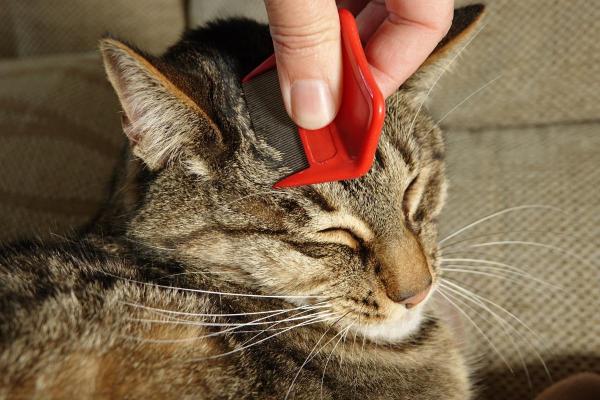How Can an Indoor Cat Get Fleas?



See files for Cats
External parasites in cats use their hosts to breed and search out new hosts. This means felines which live in groups are prone to cross-infestation. Cat colonies of feral cats often have high rates of infestation, but up to 29.6% of domestic cats also have external parasites. While ear mites are the most common, around 15.5% of domestic cats can have fleas at any given time. For this and other reasons, many guardians choose to keep their cats indoors. They do not want to put their animals at risk of a flea infestation and the possible diseases they can transmit.
With this in mind, it can be very surprising and worrying if our cat has fleas, but they don't go outside. At AnimalWised, we find out how can an indoor cat get fleas? We look at the methods of parasitization and explain why it is important to provide flea treatment to all felines, including house cats.
Fleas transferred from clothes
One of the main reasons why my cat has fleas if he doesn't leave the house is that they can be spread through our clothes. Often, this occurs due to fleas latching on to our shoes. Since our feet our closest to the ground, fleas can easily jump on to our shoes or pants leg. Our shoes can also step in matter infested with the eggs of cat fleas (Ctenocephalides felis), bringing them into our homes.
Once the eggs are inside the home, they can hatch in the warm environment. Going through the larval and pupal stages, they can develop into adults and attach themselves to the skin of our indoor cats.
Our clothes or shoes can also be vectors for adult fleas, but this is less common. This tends to occur most often with people who have come into contact with outdoor cats. Since fleas are such common parasites, it is always important to be careful when we approach or are approached by an unknown cat.
Learn more with our article on the difference between feral and wild cats.
Fleas from other animals
If our cat has fleas, but doesn't go outside, it is not only us who can bring these parasites into the home. We may not let our cat go outside, but we have to walk the dog. Dogs love to explore and will stick their nose into almost anything, roll around in the dirt and generally allow themselves to be exposed to various pathogens and parasites. Once they come back into the home, they interact with our house cat and the infestation is transferred.
We have already mentioned cat fleas (Ctenocephalides felis), but dog fleas (Ctenocephalides canis) are members of the same genus. Although they are most associated with their namesakes, cat fleas can infest dogs and dog fleas can infest cats. This is why flea treatment for all animals in the home, regardless if they have outdoor access, needs to be comprehensive.
We can learn more about parasite protection for our companion animals with our article on whether deworming is necessary for dogs.

Fleas in the house
If your cat or another animal has had fleas previously, you still may be surprised how an indoor cat can get fleas without going outside. This often happens when the cat themselves is treated for fleas, but we neglect to carry out proper hygiene of the home.
Another possibility is that a cat has been adopted or even rescued and brought inside. Some of us may discover an abandoned cat and take them in, either to house ourselves or to foster them before we can take them to a rescue shelter. Even if we take precautions and don't let them come into contact with our outdoor cat, fleas have a habit of making themselves at home very easily. The fleas can stay in carpets, furnishings, toys, beds and many other places.
Adult fleas can be more easily recognized, especially if we see them crawling about on an animal's fur. Their eggs are more difficult to see and can be spread around easily, despite not having any limbs during this stage. An adult flea can lay up to 25 eggs a day and its larvae can remain viable for up to a year in the home, due to the ambient temperature of most homes providing a suitable environment to incubate.
Some of the consequences and problems of flea infestation in cats are:
- Flea bite allergic dermatitis or DAPP: in which the itching and inflammation can be acute. It is an allergic dermatological problem triggered by sensitivity to flea bites.
- Carriers of flea tapeworms: while fleas are themselves an external parasite, they can be a vector for flea tapeworms (Dypylidium caninum) which infest via the bite, causing clinical signs such as weight loss, discomfort and diarrhea, among other symptoms.
What to do if I have flea eggs at home?
Due to the possibility of reinfestation, it is vital to eliminate fleas in the home. This should be done during any stage of the flea life cycle. Thorough cleaning of the home requires vacuuming all surfaces, cleaning with enzymatic products and getting into all the nooks and crannies of the home. If the cat has interacted with any clothes or bedding, we need to wash them at a high temperature to ensure the fleas are killed.
It is also advisable to use products with active substances against these parasites in the home. This way we can eliminate any fleas that may have remained after deep cleaning. This is in addition to the use of antiparasitic flea treatment prevention in the form of collars or pipettes in our cats.
Learn more about how fleas are spread in the home with our article explaining what happens when my cat has fleas and sleeps in my bed.
Open windows and doors
Especially in summer, another reason why my cat has fleas if they don't leave the house is because we leave the doors and windows of our home open. In this way, these spaces become places where fleas can sneak into the house.
As you already know, fleas can live on the fur of animals, but they can also live on vegetation. If you live in an area with a warm climate and your house is surrounded by plants and trees, the chances of fleas coming to your home are high. Once inside the house, fleas can hide in carpets, furniture and other dark places until they find a suitable host. To minimize this risk, it is advisable to install screens on windows and doors.
Learn more about treating fleas with our article on whether baking soda kills fleas in cats.

Do indoor cats need flea treatment?
There is a simple answer to this question. Yes, indoor cats still need flea treatment. As we have explained throughout this article, there are many ways fleas can enter our home. Some homes may be more at risk than others, but all cats should have flea treatment administered to ensure the health of themselves and all others.
In addition to maintaining health and well-being, getting rid of fleas after an infestation can be a real pain. It will take a thorough cleaning like never before and some people may even call in a professional to do it. Providing flea treatment to our cat takes seconds and is very affordable. Even for cats which are at low risk, providing flea treatment to indoor cats provides peace of mind and better safeguards their health.
Flea treatment is very safe and negative side effects are very rare. Learn more with our article explaining why a cat is acting weird after flea treatment.

This article is purely informative. AnimalWised does not have the authority to prescribe any veterinary treatment or create a diagnosis. We invite you to take your pet to the veterinarian if they are suffering from any condition or pain.
If you want to read similar articles to How Can an Indoor Cat Get Fleas?, we recommend you visit our Prevention category.







